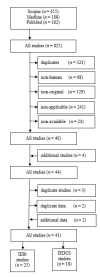Inner ear barotrauma and inner ear decompression sickness: a systematic review on differential diagnostics
- PMID: 34897597
- PMCID: PMC8923696
- DOI: 10.28920/dhm51.4.328-337
Inner ear barotrauma and inner ear decompression sickness: a systematic review on differential diagnostics
Abstract
Introduction: Inner ear barotrauma (IEBt) and inner ear decompression sickness (IEDCS) are the two dysbaric inner ear injuries associated with diving. Both conditions manifest as cochleovestibular symptoms, causing difficulties in differential diagnosis and possibly delaying (or leading to inappropriate) treatment.
Methods: This was a systematic review of IEBt and IEDCS cases aiming to define diving and clinical variables that help differentiate these conditions. The search strategy consisted of a preliminary search, followed by a systematic search covering three databases (PubMed, Medline, Scopus). Studies were included when published in English and adequately reporting one or more IEBt or IEDCS patients in diving. Concerns regarding missing and duplicate data were minimised by contacting original authors when necessary.
Results: In total, 25 studies with IEBt patients (n = 183) and 18 studies with IEDCS patients (n = 397) were included. Variables most useful in differentiating between IEBt and IEDCS were dive type (free diving versus scuba diving), dive gas (compressed air versus mixed gas), dive profile (mean depth 13 versus 43 metres of seawater), symptom onset (when descending versus when ascending or surfacing), distribution of cochleovestibular symptoms (vestibular versus cochlear) and absence or presence of other DCS symptoms. Symptoms of difficult middle ear equalisation or findings consistent with middle ear barotrauma could not be reliably assessed in this context, being insufficiently reported in the IEDCS literature.
Conclusions: There are multiple useful variables to help distinguish IEBt from IEDCS. Symptoms of difficult middle ear equalisation or findings consistent with middle ear barotrauma require further study as means of distinguishing IEBt and IEDCS.
Keywords: Decompression; Diving; ENT; Epidemiology; Hearing; Labyrinth; Vertigo.
Copyright: This article is the copyright of the authors who grant Diving and Hyperbaric Medicine a non-exclusive licence to publish the article in electronic and other forms.
Conflict of interest statement
This work was supported by the Finnish ORL-HNS Foundation under grant 20210036. The funding source had no role in the design and conduct of the study; collection, management, analysis, and interpretation of the data; preparation, review, or approval of the manuscript; or decision to submit the manuscript for publication. No conflicts of interest were declared.
Figures


References
-
- Mitchell SJ, Doolette DJ. Pathophysiology of inner ear decompression sickness: potential role of the persistent foramen ovale. Diving Hyperb Med. 2015;45:105–10. - PubMed
Publication types
MeSH terms
LinkOut - more resources
Full Text Sources
Medical
Research Materials
Miscellaneous
